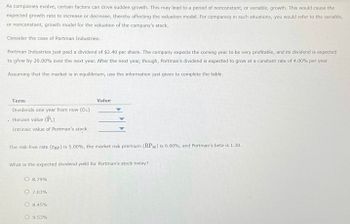
Essentials Of Investments
11th Edition
ISBN: 9781260013924
Author: Bodie, Zvi, Kane, Alex, MARCUS, Alan J.
Publisher: Mcgraw-hill Education,
expand_more
expand_more
format_list_bulleted
Concept explainers
Question
33

Transcribed Image Text:As companies evolve, certain factors can drive sudden growth. This may lead to a period of nonconstant, or variable, growth. This would cause the
expected growth rate to increase or decrease, thereby affecting the valuation model. For companies in such situations, you would refer to the variable,
or nonconstant, growth model for the valuation of the company's stock.
Consider the case of Portman Industries:
Portman Industries just paid a dividend of $2.40 per share. The company expects the coming year to be very profitable, and its dividend is expected
to grow by 20.00% over the next year. After the next year, though, Portman's dividend is expected to grow at a constant rate of 4.00% per year.
Assuming that the market is in equilibrium, use the information just given to complete the table.
Term
Dividends one year from now (D₁)
- Horizon value (P₁)
Intrinsic value of Portman's stock
The risk-free rate (TRF) is 5.00% , the market risk premium (RPM) is 6.00 %, and Portman's beta is 1.30.
What is the expected dividend yield for Portman's stock today?
O 8.79%
O 7.03%
Value
O 8.45%
O 9.53%
Expert Solution
This question has been solved!
Explore an expertly crafted, step-by-step solution for a thorough understanding of key concepts.
This is a popular solution
Trending nowThis is a popular solution!
Step by stepSolved in 3 steps

Knowledge Booster
Learn more about
Need a deep-dive on the concept behind this application? Look no further. Learn more about this topic, finance and related others by exploring similar questions and additional content below.Similar questions
- 3:43 اليوم e 12:34 تحریر Problem 7 Illustrate which of the following sentences is true or false: ve 95% the following sentearrow_forward33 34arrow_forwardKingcade Corporation keeps careful track of the time required to fill orders. Data concerning a particular order appear below: Hours 18.3 Wait time Process time Move time Queue time 1. 1 Inspection time 0.1 2.0 9.1 The manufacturing cycle efficiency (MCE) was closest to: (Round your intermediate calculations to 1 decimal place.)arrow_forward
- Rate % 10 15 20 25 303.0 $9.65067 $6.90582 $5.54598 $4.74211 $4.216043.5 9.88859 7.14883 5.79960 5.00624 4.490454.0 10.12451 7.39688 6.05980 5.27837 4.774154.5 10.36384 7.64993 6.32649 5.55832 5.066855.0 10.60655 7.90794 6.59956 5.84590 5.368225.5 10.85263 8.17083 6.87887 6.14087 5.677896.0 11.10205 8.43857 7.16431 6.44301 5.995516.5 11.35480 8.71107 7.45573 6.75207 6.320687.0 11.61085 8.98828 7.75299 7.06779 6.653027.5 11.87018 9.27012 8.05593 7.38991 6.992158.0 12.13276 9.55652 8.36440 7.71816 7.337658.5 12.39857 9.84740 8.67823 8.05227 7.689139.0 12.66758 10.14267 8.99726 8.39196 8.046239.5 12.93976 10.44225 9.32131 8.73697 8.4085410.0 13.21507 10.74605 9.65022 9.08701 8.7757210.5 13.49350 11.05399 9.98380 9.44182 9.1473911.0 13.77500 11.36597 10.32188 9.80113 9.52323…arrow_forwardThe answer is 1,130.55arrow_forward
arrow_back_ios
arrow_forward_ios
Recommended textbooks for you
 Essentials Of InvestmentsFinanceISBN:9781260013924Author:Bodie, Zvi, Kane, Alex, MARCUS, Alan J.Publisher:Mcgraw-hill Education,
Essentials Of InvestmentsFinanceISBN:9781260013924Author:Bodie, Zvi, Kane, Alex, MARCUS, Alan J.Publisher:Mcgraw-hill Education,

 Foundations Of FinanceFinanceISBN:9780134897264Author:KEOWN, Arthur J., Martin, John D., PETTY, J. WilliamPublisher:Pearson,
Foundations Of FinanceFinanceISBN:9780134897264Author:KEOWN, Arthur J., Martin, John D., PETTY, J. WilliamPublisher:Pearson, Fundamentals of Financial Management (MindTap Cou...FinanceISBN:9781337395250Author:Eugene F. Brigham, Joel F. HoustonPublisher:Cengage Learning
Fundamentals of Financial Management (MindTap Cou...FinanceISBN:9781337395250Author:Eugene F. Brigham, Joel F. HoustonPublisher:Cengage Learning Corporate Finance (The Mcgraw-hill/Irwin Series i...FinanceISBN:9780077861759Author:Stephen A. Ross Franco Modigliani Professor of Financial Economics Professor, Randolph W Westerfield Robert R. Dockson Deans Chair in Bus. Admin., Jeffrey Jaffe, Bradford D Jordan ProfessorPublisher:McGraw-Hill Education
Corporate Finance (The Mcgraw-hill/Irwin Series i...FinanceISBN:9780077861759Author:Stephen A. Ross Franco Modigliani Professor of Financial Economics Professor, Randolph W Westerfield Robert R. Dockson Deans Chair in Bus. Admin., Jeffrey Jaffe, Bradford D Jordan ProfessorPublisher:McGraw-Hill Education

Essentials Of Investments
Finance
ISBN:9781260013924
Author:Bodie, Zvi, Kane, Alex, MARCUS, Alan J.
Publisher:Mcgraw-hill Education,



Foundations Of Finance
Finance
ISBN:9780134897264
Author:KEOWN, Arthur J., Martin, John D., PETTY, J. William
Publisher:Pearson,

Fundamentals of Financial Management (MindTap Cou...
Finance
ISBN:9781337395250
Author:Eugene F. Brigham, Joel F. Houston
Publisher:Cengage Learning

Corporate Finance (The Mcgraw-hill/Irwin Series i...
Finance
ISBN:9780077861759
Author:Stephen A. Ross Franco Modigliani Professor of Financial Economics Professor, Randolph W Westerfield Robert R. Dockson Deans Chair in Bus. Admin., Jeffrey Jaffe, Bradford D Jordan Professor
Publisher:McGraw-Hill Education